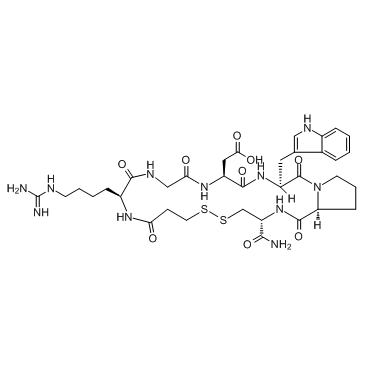| Cas No.: | 1248559-53-6 |
| Chemical Name: | Eptifibatide acetate |
| Synonyms: | MPA-HAR-GDWPC-NH2 |
| SMILES: | NC(NCCCC[C@@H]1NC(CCSSC[C@@H](C(N)=O)NC([C@@H]2CCCN2C([C@@H](NC([C@@H](NC(CNC1=O)=O)CC(O)=O)=O)Cc(c[nH]3)c4c3cccc4)=O)=O)=O)=N |
| Formula: | C37H53N11O11S2 |
| M.Wt: | 892.01 |
| Purity: | >98% |
| Sotrage: | 2 years -20°C Powder, 2 weeks 4°C in DMSO, 6 months -80°C in DMSO |
| Description: | Eptifibatide, also co-promoted by Schering-Plough/Essex, is an antiplatelet drug of the glycoprotein IIb/IIIa inhibitor class. Eptifibatide is a cyclic heptapeptide derived from a protein found in the venom of the southeastern pygmy rattlesnake (Sistrurus miliarius barbouri). It belongs to the class of the arginin-glycin-aspartat-mimetics and reversibly binds to platelets. Eptifibatide has a short half-life. The drug is the third inhibitor of GPIIb/IIIa that has found broad acceptance after the specific antibody abciximab and the non-peptide tirofiban entered the global market. |
| References: | [1]. Amoroso, G., et al., Eptifibatide and abciximab exhibit equivalent antiplatelet efficacy in an experimental model of stenting in both healthy volunteers and patients with coronary artery disease. J Cardiovasc Pharmacol, 2001. 38(4): p. 633-41. [2]. Schwarz, M., et al., Reversibility versus persistence of GPIIb/IIIa blocker-induced conformational change of GPIIb/IIIa (alphaIIbbeta3, CD41/CD61). J Pharmacol Exp Ther, 2004. 308(3): p. 1002-11. |

 To enhance service speed and avoid tariff delays, we've opened a US warehouse. All US orders ship directly from our US facility.
To enhance service speed and avoid tariff delays, we've opened a US warehouse. All US orders ship directly from our US facility.




















